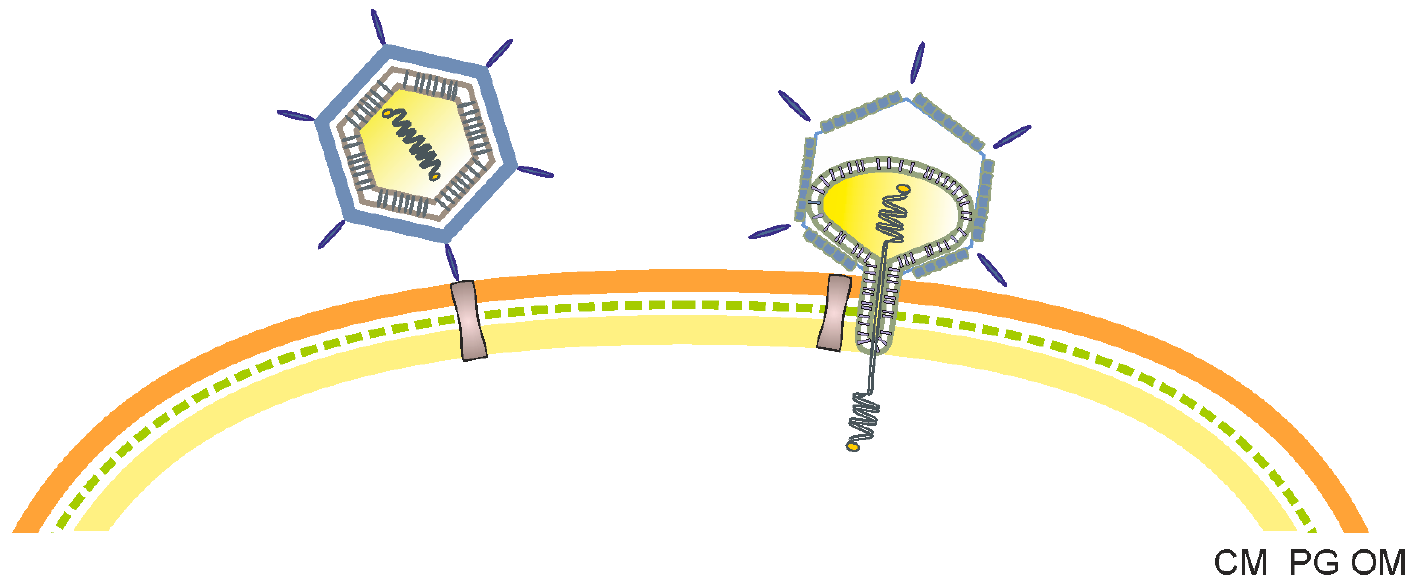Tectivirus on:
[Wikipedia]
[Google]
[Amazon]
''Tectiviridae'' is a family of
 The
The
Unclassified Tectiviridae
NCBI Taxonomy. * '' Thermus virus phiKo'' * '' Microbacterium virus Badulia'' * '' Microbacterium virus MuffinTheCat''
ICTVdB—The Universal Virus Database
ICTVdB Management (2006). 00.068. Tectiviridae. In: ICTVdB—The Universal Virus Database, version 3. Büchen-Osmond, C. (Ed), Columbia University, New York, USA
Eighth Report of the International Committee on Taxonomy of Viruses H.V. Van Regenmortel, D.H.L. Bishop, M. H. Van Regenmortel, Claude M. Fauquet (Eds)
ICTV
{{Taxonbar, from=Q569755 Bacteriophages
viruses
A virus is a submicroscopic infectious agent that replicates only inside the living cells of an organism. Viruses infect all life forms, from animals and plants to microorganisms, including bacteria and archaea.
Since Dmitri Ivanovsky's ...
with 10 species in five genera. Bacteria serve as natural hosts. Tectiviruses have no head-tail structure, but are capable of producing tail-like tubes of ~ 60×10 nm upon adsorption or after chloroform
Chloroform, or trichloromethane, is an organic compound with formula C H Cl3 and a common organic solvent. It is a colorless, strong-smelling, dense liquid produced on a large scale as a precursor to PTFE. It is also a precursor to various ...
treatment. The name is derived from Latin
Latin (, or , ) is a classical language belonging to the Italic languages, Italic branch of the Indo-European languages. Latin was originally a dialect spoken in the lower Tiber area (then known as Latium) around present-day Rome, but through ...
''tectus'' (meaning 'covered').
Virology
 The
The virion
A virus is a submicroscopic infectious agent that replicates only inside the living cells of an organism. Viruses infect all life forms, from animals and plants to microorganisms, including bacteria and archaea.
Since Dmitri Ivanovsky's ...
s of ''Tectiviridae'' species are non-enveloped, icosahedral and display a pseudo T=25 symmetry. The capsid
A capsid is the protein shell of a virus, enclosing its genetic material. It consists of several oligomeric (repeating) structural subunits made of protein called protomers. The observable 3-dimensional morphological subunits, which may or ma ...
has two layers. The outer layer is a protein structure of 240 capsid proteins trimers, and the inner one is a proteinaceous lipid membrane which envelopes the virus genome
In the fields of molecular biology and genetics, a genome is all the genetic information of an organism. It consists of nucleotide sequences of DNA (or RNA in RNA viruses). The nuclear genome includes protein-coding genes and non-coding ...
. Apical spikes extending about 20 nanometers
330px, Different lengths as in respect to the molecular scale.
The nanometre (international spelling as used by the International Bureau of Weights and Measures; SI symbol: nm) or nanometer (American and British English spelling differences#-re ...
(nm) protrude from the icosahedrons vertices.
The genome is a single molecule of linear double-stranded DNA of 15 kilo bases in length, and has 30 open reading frames. It forms a tightly packed coil and encodes several structural proteins. It encodes about 30 proteins that are transcribed in operons. At least 9 structural proteins are present in the viron. The genome is about 66 megaDalton
Dalton may refer to:
Science
* Dalton (crater), a lunar crater
* Dalton (program), chemistry software
* Dalton (unit) (Da), the atomic mass unit
* John Dalton, chemist, physicist and meteorologist
Entertainment
* Dalton (Buffyverse), minor ch ...
s in weight and constitutes 14–15% of the virion by weight. Lipid
Lipids are a broad group of naturally-occurring molecules which includes fats, waxes, sterols, fat-soluble vitamins (such as vitamins A, D, E and K), monoglycerides, diglycerides, phospholipids, and others. The functions of lipids in ...
s constitute a further 15% by weight. Carbohydrates
In organic chemistry, a carbohydrate () is a biomolecule consisting of carbon (C), hydrogen (H) and oxygen (O) atoms, usually with a hydrogen–oxygen atom ratio of 2:1 (as in water) and thus with the empirical formula (where ''m'' may or m ...
are not present.
Life cycle
Viral replication is cytoplasmic. Entry into the host cell is achieved by adsorption into the host cell. After adsorption to the host cell surface the virion extrudes a tail-tube structure through a vertex for genome delivery into the host. Replication follows the DNA strand displacement model. DNA-templated transcription is the method of transcription. Capsid proteins polymerize around a lipoprotein vesicle translocated in the cytoplasm by virion assembly factors. Mature virons are released by lysis, which, in the case of PRD1, is achieved with the aid of virus-encoded lysis machinery consisting of four proteins: P15 (endolysin
Lysins, also known as endolysins or murein hydrolases, are hydrolytic enzymes produced by bacteriophages in order to cleave the host's cell wall during the final stage of the lytic cycle. Lysins are highly evolved enzymes that are able to target ...
), P35 (holin), P36 and P37 (homologues of the Rz/Rz1 proteins of phage lambda).
Taxonomy
''Tectiviridae'' contains the following genera and species: * '' Alphatectivirus'' ** '' Pseudomonas virus PR4'' ** ''Pseudomonas virus PRD1
''Pseudomonas'' is a genus of Gram-negative, Gammaproteobacteria, belonging to the family Pseudomonadaceae and containing 191 described species. The members of the genus demonstrate a great deal of metabolic diversity and consequently are able to ...
''
* '' Betatectivirus''
** '' Bacillus virus AP50''
** '' Bacillus virus Bam35''
** '' Bacillus virus GIL16''
** '' Bacillus virus Wip1''
* '' Deltatectivirus''
** '' Streptomyces virus Forthebois''
** '' Streptomyces virus WheeHeim''
* '' Epsilontectivirus''
** '' Rhodococcus virus Toil''
* '' Gammatectivirus''
** '' Gluconobacter virus GC1''
Other unassigned phages:NCBI Taxonomy. * '' Thermus virus phiKo'' * '' Microbacterium virus Badulia'' * '' Microbacterium virus MuffinTheCat''
References
Further reading
ICTVdB—The Universal Virus Database
ICTVdB Management (2006). 00.068. Tectiviridae. In: ICTVdB—The Universal Virus Database, version 3. Büchen-Osmond, C. (Ed), Columbia University, New York, USA
Eighth Report of the International Committee on Taxonomy of Viruses H.V. Van Regenmortel, D.H.L. Bishop, M. H. Van Regenmortel, Claude M. Fauquet (Eds)
External links
ICTV
{{Taxonbar, from=Q569755 Bacteriophages